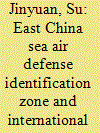|
|
|
Sort Order |
|
|
|
Items / Page
|
|
|
|
|
|
|
| Srl | Item |
| 1 |
ID:
139152


|
|
|
|
|
| Summary/Abstract |
Originating at the height of the Cold War, Air Defense Identification Zones (ADIZs), i.e. non-territorial airspace unilaterally designated by States for aircraft identification, had not encountered substantial protests until China's declaration of the East China Sea ADIZ in November 2013. Debates center not on the right to establish the ADIZ per se, but primarily on the purported application of identification rules to traversing aircraft, its overlap with pre-existing ADIZs claimed by other States, and the coverage of contested islands and rocks. This article argues that the identification of traversing civil aircraft does not jeopardize the paramount safety of international civil aviation, imposes only slight burden upon civil aircraft, and has garnered wide compliance. The identification of traversing military aircraft is a legitimate measure for coastal States to safeguard their security interest, and is constantly conducted by many States on a de facto basis. The overlap with ADIZs of other States and coverage of contested islands and rocks do not contradict international law and are legitimate measures for the maintenance of maritime and territorial interests. It is further suggested that all relevant States should negotiate mutually acceptable arrangements to avoid miscalculation and escalation, and to minimize confusions and inconveniences caused to third-party States.
|
|
|
|
|
|
|
|
|
|
|
|
|
|
|
|
| 2 |
ID:
171257


|
|
|
|
|
| Summary/Abstract |
This note provides a survey of the practice of States on ADIZs. It is found that while some ADIZs are entirely within territorial airspace, most extend beyond the outer limit into the airspace above the EEZs and even the high seas; and in the part beyond territorial airspace, transiting aircraft are prevalently subject to identification. Transiting military aircraft, which most of the time refuse to identify themselves voluntarily by submitting a flight plan or reporting their positions, may nevertheless be identified passively through radar detection, radio communication or close visual check. As most ADIZs are within the claiming State’s FIRs, transiting civil aircraft can be identified “unconsciously” through civil air traffic control. Where an ADIZ extends beyond the claiming State’s FIRs, most transiting civil aircraft comply with voluntary identification measures, presumably due to the light extra burden incurred. The non-compliant are easy to identify through passive means such as radar detection and radio communication, with the use of close visual check highly unnecessary.
|
|
|
|
|
|
|
|
|
|
|
|
|
|
|
|
|
|
|
|
|